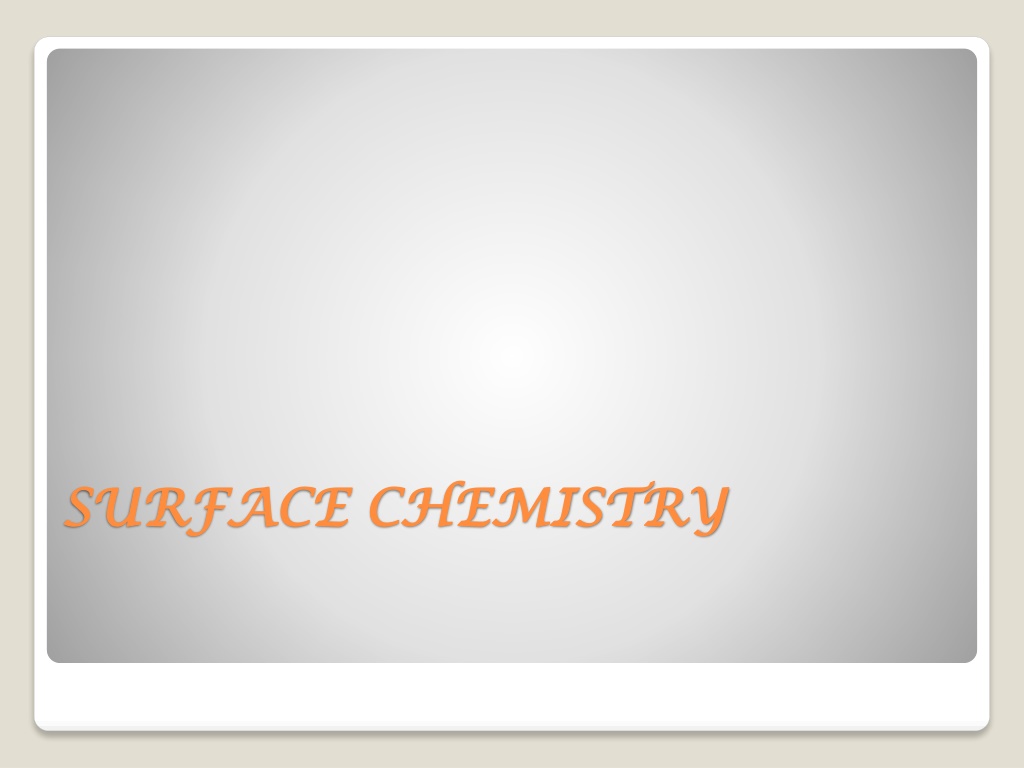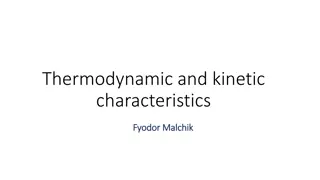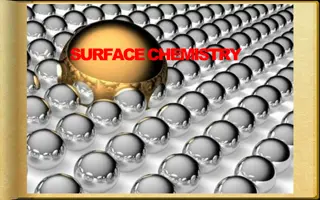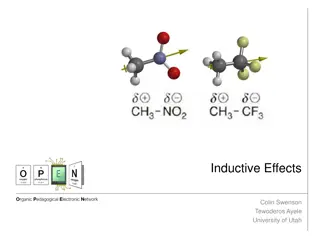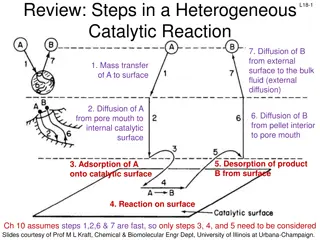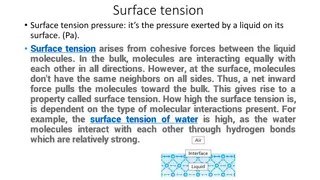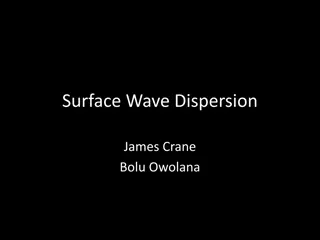Understanding Surface Chemistry and Adsorption Phenomenon
Surface chemistry explores the interactions that occur at surfaces and interfaces, with adsorption being a key phenomenon. Adsorption involves the concentration of molecules on a surface, with adsorbents and adsorbates playing crucial roles. Desorption, the opposite process, removes adsorbed substances. Various materials like activated carbon and silica gel act as adsorbents. Different types of adsorption, such as positive and negative adsorption, as well as physical and chemical adsorption, exhibit specific characteristics. Factors like the nature of adsorbates, surface area of adsorbents, temperature, and pressure influence the process of adsorption. The Freundlich isotherm is a graphical representation commonly used to study adsorption behavior.
Download Presentation

Please find below an Image/Link to download the presentation.
The content on the website is provided AS IS for your information and personal use only. It may not be sold, licensed, or shared on other websites without obtaining consent from the author. Download presentation by click this link. If you encounter any issues during the download, it is possible that the publisher has removed the file from their server.
E N D
Presentation Transcript
SURFACE CHEMISTRY SURFACE CHEMISTRY
Adsorption The phenomenon of higher concentration of any molecular species at the surface than in the bulk Adsorbent The substance on the surface of which adsorption takes place is called adsorbent Adsorbate The substance which is being adsorbed on the surface of another substance. Desorption The process of removal of an adsorbed substance from the surface on which it is absorbed
Adsorbent Materials Activated Carbon Activated Alumina Silica Gel Molecular Sieves (Zeolites) Polar and Non-polar adsorbents
Types of Adsorption Positive adsorption occurs when the concentration of adsorbate is higher on the surface of adsorbent than in the bulk. Negative adsorption occurs when the concentration of adsorbate is less on the surface of adsorbent than in the bulk.
Types of adsorption 1. Physical adsorption 2. Chemical adsorption Comparison between physisorption and chemisorption S. No. Physical adsorption 1 Caused by intermolecular van der Waals' forces 2 It is not specific 3 It is reversible 4 Heat of adsorption is low (20-40 kJ/mol) High heat of adsorption (80-240 kJ/mol) 5 Low temperature is favourable 6 Results multilayer adsorption Chemical adsorption Caused by chemical bond formation It is highly specific It is irreversible Increases with high temperature Results unimolecular layer
Factors affecting adsorption Effect of adsorbate: The easily liquifiable gases like NH3, HCl, CO2 etc. are adsorbed to a greater extent than the permanent gases such as H2 ,O2, N2, etc. Effect of specific area of the absorbent: The greater the specific area of the solid, the greater would be its adsorbing capacity. Effect of temperature:adsorption decreases with increase in temperature. Effect of pressure: An increase in pressure causes an increase in the magnitude of adsorption of an adsorbent.
Freundlich Isotherm A graph between the amount (x/m) adsorbed by an adsorbent and the equilibrium pressure of the adsorbate at constant temperature is called adsorption isotherm At low pressure the graph is nearly straight line x m 1 p At high pressure x/m becomes independent of p x m 0 p Over a narrow range of p m = K p 1/n x
Langmuir adsorption isotherm: Combining equations (1) and (2): ap + = x/m 1 bp a = ka x ka /kd b = ka/kd The values of constants a and b depend upon the nature of adsorbate, nature of solid adsorbent and temperature.
Summary of adsorption isotherms Name Isotherm equation x = m 1+bp Application Note Langmuir Chemisorption and physisorption Useful in analysis of reaction mechanism ap Freundlich Chemisorptions and physisorption Easy to fit adsorption data x=Kp m 1/n
Adsorption isobar Graph between the amount adsorbed(x/m) and temperature at a constant equilibrium pressure of adsorbate gas is known as adsorption isobar Chemisorption isobar shows an initial increase with temperature and then expected decrease .The initial increase is because of the fact that the heat supplied acts as activation energy required in chemisorption.
Application of Adsorption In clarification of sugar In gas masks In catalysis In adsorption indicators In chromatographic analysis In softening of hard water In preserving vacuum In paint industry In removing moisture from air in the storage of delicate instruments
DIFFERENT PHYSICAL FORMS DIFFERENT PHYSICAL FORMS OF ACTIVATED CARBON OF ACTIVATED CARBON pge_mouseove_01_01_over pge_mouseove_02_01_over pge_mouseove_03_01_over
Need to make chemicals faster Most Reactions are too slow to be useful...
Role of a Catalyst Catalysts speed up a chemical reaction without being used up... Catalyst-Reactants Catalyst + Reactants Catalyst + Products
Catalysis Positive catalysis MnO 270 C + 2 2KClO 2KCl 3O 3 2 Negative catalysis Alcohol + + 2CHCl O 2COCl 2HCl 3 2 2 Auto catalysis + + CH COOC H H O CH COOH 2 5 C H OH 3 2 5 2 3
Ways to Make Chemicals Faster Temperature Pressure Disadvantage--Cause Explosions Disadvantage--Too hot! Catalysts!!!! Add other Chemicals Disadvantage--Costly Disadvantage--Separate chemicals
